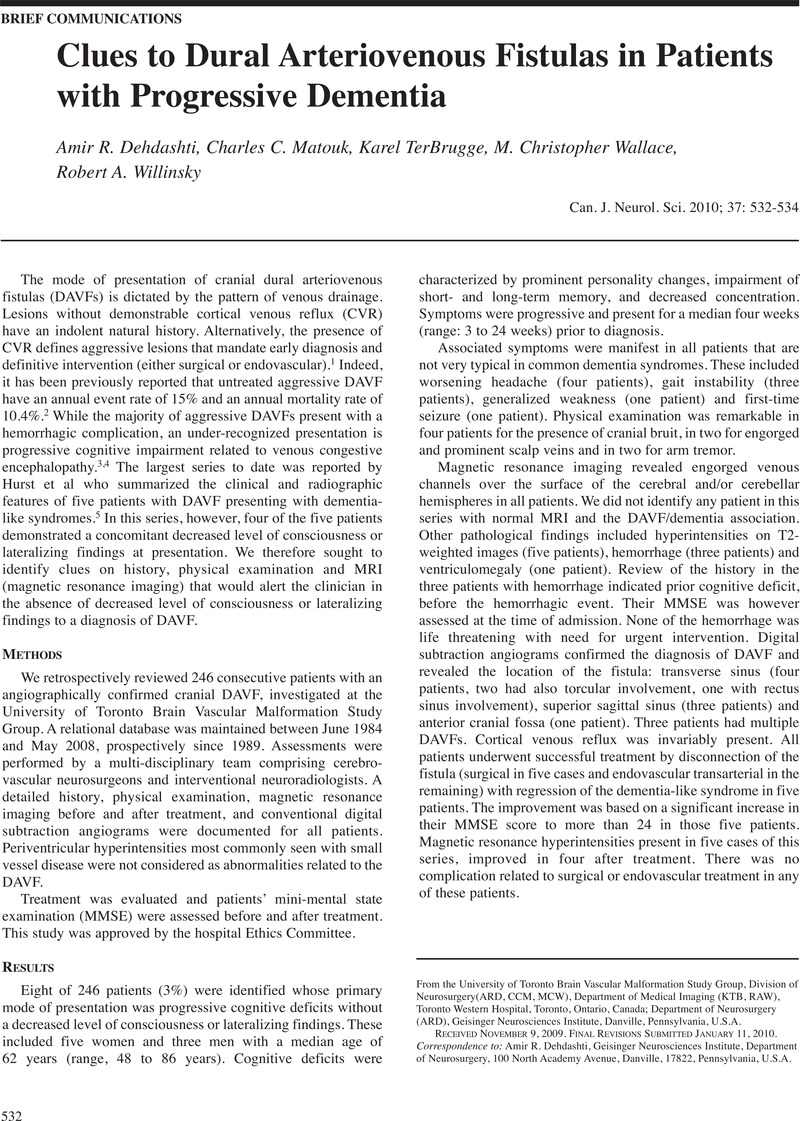Crossref Citations
This article has been cited by the following publications. This list is generated based on data provided by Crossref.
Ebinu, J.O.
Matouk, C.C.
Wallace, M.C.
Terbrugge, K.G.
and
Krings, T.
2011.
Hydrocephalus Secondary to Hydrodynamic Disequilibrium in an Adult Patient with a Choroidal-Type Arteriovenous Malformation.
Interventional Neuroradiology,
Vol. 17,
Issue. 2,
p.
212.
Letourneau‐Guillon, Laurent
Wada, Ryan
and
Kucharczyk, Walter
2012.
Imaging of prion diseases.
Journal of Magnetic Resonance Imaging,
Vol. 35,
Issue. 5,
p.
998.
Letourneau-Guillon, L.
and
Krings, T.
2012.
Simultaneous Arteriovenous Shunting and Venous Congestion Identification in Dural Arteriovenous Fistulas Using Susceptibility-Weighted Imaging: Initial Experience.
American Journal of Neuroradiology,
Vol. 33,
Issue. 2,
p.
301.
Zako, Masahiro
Murata, Kazuhiro
Inukai, Takashi
Yasuda, Muneyoshi
and
Iwaki, Masayoshi
2014.
Long-term progressive deterioration of visual function after papilledema improved by embolization of a dural arteriovenous fistula in the sigmoid sinus: a case report.
Journal of Medical Case Reports,
Vol. 8,
Issue. 1,
Letourneau-Guillon, Laurent
Cruz, Juan Pablo
and
Krings, Timo
2015.
CT and MR imaging of non-cavernous cranial dural arteriovenous fistulas: Findings associated with cortical venous reflux.
European Journal of Radiology,
Vol. 84,
Issue. 8,
p.
1555.
Holekamp, Terrence F.
Mollman, Matthew E.
Murphy, Rory K. J.
Kolar, Grant R.
Kramer, Neha M.
Derdeyn, Colin P.
Moran, Christopher J.
Perrin, Richard J.
Rich, Keith M.
Lanzino, Giuseppe
and
Zipfel, Gregory J.
2016.
Dural arteriovenous fistula-induced thalamic dementia: report of 4 cases.
Journal of Neurosurgery,
Vol. 124,
Issue. 6,
p.
1752.
Brito, Arnaldo
Tsang, Anderson Chun On
Hilditch, Christopher
Nicholson, Patrick
Krings, Timo
and
Brinjikji, Waleed
2019.
Intracranial Dural Arteriovenous Fistula as a Reversible Cause of Dementia: Case Series and Literature Review.
World Neurosurgery,
Vol. 121,
Issue. ,
p.
e543.
Armocida, Daniele
Palmieri, Mauro
Paglia, Francesco
Berra, Luigi Valentino
D’Angelo, Luca
Frati, Alessandro
and
Santoro, Antonio
2021.
Rapidly progressive dementia and Parkinsonism as the first symptoms of dural arteriovenous fistula. The Sapienza University experience and comprehensive literature review concerning the clinical course of 102 patients.
Clinical Neurology and Neurosurgery,
Vol. 208,
Issue. ,
p.
106835.
Tu, Tianqi
Song, Zihao
Ma, Yongjie
Yang, Chengbin
Su, Xin
He, Chuan
Li, Guilin
Hong, Tao
Sun, Liyong
Hu, Peng
Zhang, Peng
Ye, Ming
and
Zhang, Hongqi
2022.
Adult dural arteriovenous fistulas in Galen region: More to be rediscovered.
Frontiers in Neurology,
Vol. 13,
Issue. ,
Pichardo-Rojas, Pavel S.
Marín-Castañeda, Luis A.
De Nigris Vasconcellos, Fernando
Flores-López, Shadia I.
Coria-Medrano, Adrian
de Teresa López-Zepeda, Perla
Sánchez-Serrano, Claudia D.
Torres-Chávez, Mario C.
Escobar-López, Jesús M.
Choque-Ayala, Luz C.
Jowah, Gorbachev
and
Rangel-Castilla, Leonardo
2024.
Simultaneous Parkinsonism and Dementia as Initial Presentation of Intracranial Dural Arteriovenous Fistulas: A Systematic Review.
World Neurosurgery,
Vol. 184,
Issue. ,
p.
e554.





